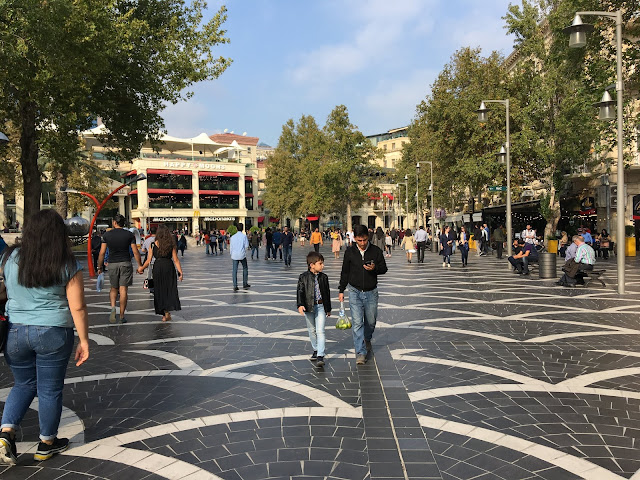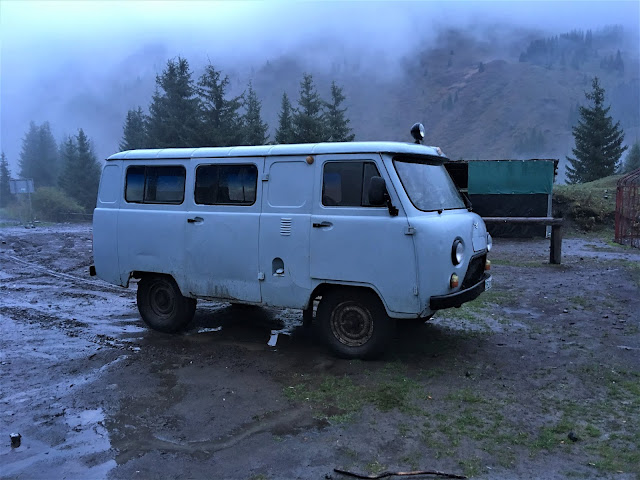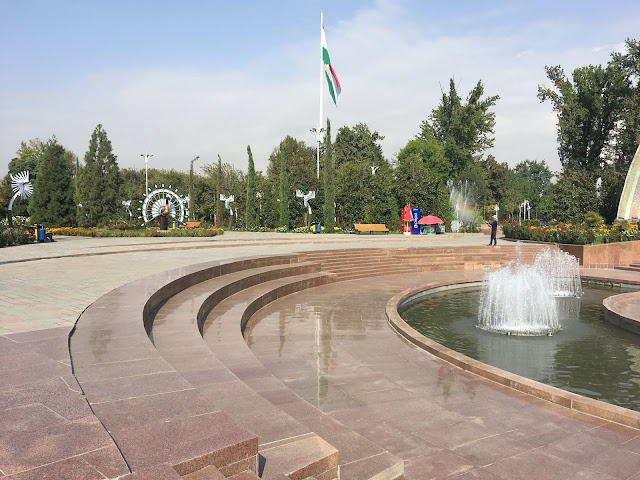CENTRAL
ASIA ADVENTURE – PART IV
After a nice visit in Khiva, we said goodbye to nine
fellow travellers and our guide, Aktilek, and seven of us set off into the
unknown, Turkmenistan. Our new guide, Arslan, explained to us that all we
needed to know about the country is that it is a good country and that the
President, Gerbanguly Berdimuhamedow, is a good President. No more questions!
While the country is open to visitors, it’s not easy to travel there. You need
to be with a recognized tour group at all times and a visa costs $67 US.
Turkmenistan will welcome 20,000 visitors in 2019. To put that number into
perspective, Charlottetown welcomes 10,000 passengers and crew on a day when
three cruise ships call at the city.
Our first night in the country, we stayed at the
luxurious Dashoguz Hotel, clad in white marble on the outside and just as fancy
on the inside. There was internet but, since many sites are blocked by the
government, it was of little use. Whatever! It’s what we expected.
Next morning, we were met by a convoy of three
late-model Toyota 4x4s. All bore government license plates and were driven by what
looked like ex-military men. The drive to Kunya Urgench took about an hour.
While there, we visited ruins of the ancient capital of the Khorezmian Empire,
a UNESCO World Heritage Site. Kunya Urgench is an important pilgrimage site for
the people of Turkmenistan. The minaret in the photo is the tallest in Central
Asia at 62 metres.
After a delicious lunch, we headed south on the main
road between Dashoguz and Ashgabat. We drove on the road, on the shoulder, and
in the ditch; sometimes it seemed like all three at once! The condition of the
road defied description. Finally, after about 100 kilometres of bouncing
around, we hit a stretch of better pavement, still nothing more than a base
coat of asphalt though. One of our vehicles died but was soon replaced by
another. Our drivers hit speeds of 120 kph as we hung on for dear life. The
objective seemed to be to get us to the gas crater at Darvasa at sunset. The
last part of the drive was off-road over sand dunes. We made it just in time!
The crater, known as “The Gates of Hell”, is one of
the most unusual sites we’ve ever seen. The Soviets drilled for oil here in
1971 but hit only natural gas. The gas had formed a pocket and, upon being
released, the pocket collapsed into itself, creating the large crater. Since
it’s normal to burn off a pocket of gas, they set fire to it believing it would
flame out in a couple of weeks. To everyone’s surprise, it’s still burning 48
years later with no end in sight.

The yurt camp that housed us for the night was
clearly the most luxurious of the four we stayed in. it even had a bar. Unlike
the first three, we had a yurt all to ourselves! But again, we damn near froze!
Although the Karakum Desert is warm during the day, the temperature drops to 5
degrees C or so at night. Next morning, our three-vehicle convoy drove south through
the desert until we reached the capital of Turkmenistan, Ashgabat, surely one
of the strangest cities in the world. After over 3,000 kilometers on some of
the worst roads ever, we were glad to see the driving part of our adventure
come to an end. Our lodging for the next two nights was the Wedding Palace.
The photo says it all! Everything here is over the top.

In Xanadu did Kubla Khan
A
stately pleasure-dome decree…
I was reminded of the opening words of Samuel Taylor
Coleridge’s poem (remembered from high school) as I tried to absorb the marvels
of Ashgabat. Block after block of brilliant white marble buildings, all erected
since the country gained its independence. Enormous monuments adorn the centers
of every roundabout. The broad boulevards and spacious monuments are cleaned
every day and the parks are immaculately groomed. We drove past the Olympic
Village, complete with 55,000 seat stadium, monorail, athletes’ village, and
all the venues needed to hold major sporting events. Each of them spotless but
apparently empty. I dared not ask how many international sporting events have
been held here since they opened.
I can say this about Turkmenistan. It is a land of
stark contrasts; from the desert that covers 80% of its land area to the
fertile irrigated plains; from the poverty in rural areas to the conspicuous
wealth displayed in Ashgabat’s high-end shopping center; from the controls
imposed on travel and internet access to the government’s stated intention to increase
visitation and private investment. And I could go on. The photos below show the high-end hotel just up the hill from ours, a small copy of Dubai's Burj Al-Arab, and an empty boulevard that would be ideal for a Formula 1 Grand Prix. We had coffee on the eighteenth floor of the fancy hotel and looked down on a Jack Nicklaus-designed golf course, also empty.
Winston Churchill, speaking of Russia in 1939,
called it a riddle, wrapped in a mystery, inside an enigma. A description that
fits Turkmenistan to a tee. Still, we’re glad we experienced this unusual
country. It’s one that should be on every intrepid traveller’s list.

We said goodbye to Arslan and to our travel
companions and spent a few days in another former Soviet Republic, Azerbaijan.
The capital city, Baku, has a population of 2.5 million, about one-quarter of
the country’s total. We arrived at our hotel at 4:30 am, dead tired, after
taking the red-eye from Ashgabat. The night manager, Shahin, must have pulled a
few strings to get us an early check-in; a much-appreciated gesture. The Boutique
19 Hotel is located right in the center of the old city and within walking
distance of the waterfront. It’s the nicest hotel we’ve stayed in since we left
home four weeks ago.
We strolled through the narrow streets in the walled
section, a UNESCO World Heritage Site, made our way down to the waterfront
boulevard, and visited the beautiful national Carpet Museum, a real masterpiece.
Watching women make the carpets was dizzying. The process is extremely complex,
kind of like watching someone calculate using an abacus: impossible to follow. We
ended our day with a hamburger and fries at the Hard Rock Café, a
welcome return to a familiar meal after four weeks of local food. (By the way, the third photo is not a painting, it's a carpet.)

It’s evident as soon as you step onto the sidewalk
that Baku is a European city. The prices are definitely European as well! The
Ural Mountains run north-south from the Arctic Ocean to Kazakhstan, dividing
Europe from Asia. So Azerbaijan is geographically part of Europe, certainly
more European than Asian; perhaps more accurately a crossroads between the two.
Azerbaijan is a rich country, far better off
economically that any of the five Stans, mainly because of its significant
reserves of oil and natural gas. Agriculture and tourism are also big here. Average
per capita income is about twice that of Kazakhstan (richest of the Stans) and
about half that of Canada.
The
more we saw of Baku, the more we liked it. It’s a very walkable city and very
clean. We climbed the Maiden’s Tower and visited the Shirvanshah Palace. Elva did
some shopping and we played tourist for a few days. We climbed the hill to see the Flame Towers up close
and took the metro to visit the magnificent Heydar Aliyev Center, a signature
landmark of modern Baku. Close by, I found a barber shop and ducked in for a
trim. The guy was an artist. For the first time in my life, I had an ear waxing!
I considered a Brazilian but thought I’d had enough trauma for one day.
On our last day in Azerbaijan, we joined a Viatour group for a visit to a few of the top tourist attractions outside the city: the Gobustan petroglyphs, the mud volcanoes, and the fire temple. It was a nice way to end our short visit to this fascinating country. A word of advice to people who are looking for a stopover alternative in this part of the world. Dubai may have all the superlatives (tallest this and biggest that), but don’t overlook Baku!
On our last day in Azerbaijan, we joined a Viatour group for a visit to a few of the top tourist attractions outside the city: the Gobustan petroglyphs, the mud volcanoes, and the fire temple. It was a nice way to end our short visit to this fascinating country. A word of advice to people who are looking for a stopover alternative in this part of the world. Dubai may have all the superlatives (tallest this and biggest that), but don’t overlook Baku!
Central Asia is huge, even by Canadian standards.
The total land area of the five Stans is equal to that of Québec, Ontario,
British Columbia, and Alberta combined. Our experience exceeded our
expectations. This little-known corner of the world is a treasure to be
discovered and experienced. We didn’t feel crowded by tourists everywhere, but
their presence is being felt in the region, particularly in the historic cities
of Samarkand, Bukhara, and Khiva. It’s clear that the government of Uzbekistan
recognizes its tourism potential; city centers of Bukhara and Khiva are busy
construction zones. Go now before these places are overrun.
Having seen enough mosques and madrassas, Paul, yours truly, and Jeff sat down one day to work on the world's problems.
We can’t say enough good things about the people in
these countries. They are friendly, polite, industrious, and curious. They seem
genuinely proud of what each of their countries has achieved since independence
and are hopeful for the future. We saw no graffiti, no idleness, and few signs
of homelessness. Not once were we approached by someone asking for money. The
countryside may be poor but there is little garbage lying around and the cities
display a level of cleanliness that would be the envy of many first-world
countries.
Tourism infrastructure and service levels are in
need of improvement; no question. Few of us on the tour escaped at least a mild
case of la touristique. The food varied from quite good to just passable
and accommodation standards were all over the map. Every day, I gave thanks for
a firm stool! Elva wasn’t always so lucky… Eventually, our intestinal
microbiota adjusted and their variety is, I’m sure, vastly improved!
As for their systems of government, twenty-eight years
of independence is not a long time. Each of the five has developed its own
system, some more repressive than others. However, one thing we’ve learned in
our travels is that democracy is not always the best form of government and
dictatorship not always the worst. The people of the Stans see their present
situation as much better than what they experienced under the USSR — the
Bolsheviks as they call the Russians — and more secular than would be the case
in an Islamic republic like Iran or Afghanistan. In every country except
Turkmenistan, where we were not allowed to ask probing questions, the people
displayed a hopeful attitude. They’re not looking for radical change, just slow
and steady progress.
As for G Adventures, this was not our first
experience with the company. Eight years ago, we did Machu Picchu, the Amazon
jungle and the Galapagos Islands with them. Our CEOs, as well as local guides
with Panjakent Intour and Owadan Travel, were eager to please and did their
best to make our visit enjoyable and informative. We would not hesitate to
recommend this tour, the Five Stans of the Silk Road.

















































